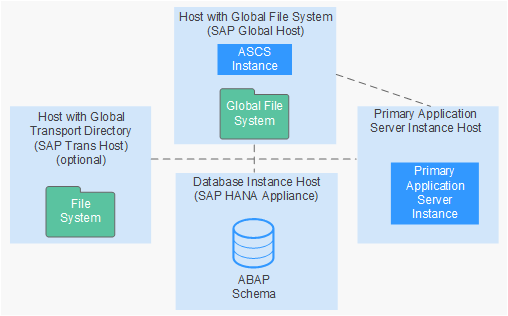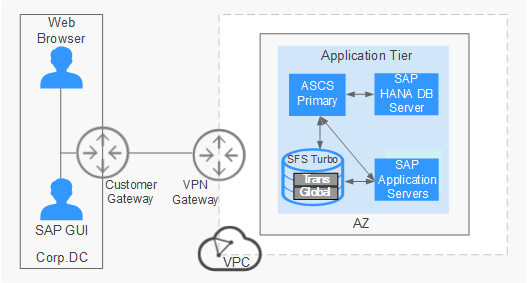Distributed Deployment
Figure 1 shows the distributed deployment mode of SAP NetWeaver.

In the distributed deployment mode, the SAP NetWeaver system consists of multiple SAP instances. An SAP instance is a group of processes that are simultaneously started or stopped. In the distributed SAP NetWeaver system, all instances are deployed on separated ECSs. The main instances are as follows:
- ABAP Central Services instance (ASCS instance)
- SAP HANA database instance (DB instance)
- Primary application server instance (PAS instance)
Figure 2 shows the recommended distributed deployment mode of SAP NetWeaver on the public cloud.

The description of each part is the same as that in section Standard Deployment. The difference is that ASCS instance and PAS instance are deployed on different ECSs in the distributed deployment mode. Applying for multiple ECSs as application servers are scheduled by Web Dispatcher. SFS Turbo provides the file sharing service. Global files are shared by all SAP NetWeaver ECSs. Trans files are attached to SAP application servers.
Table 1 shows the file systems planned for the distributed deployment mode.
|
Mount Point |
File System Type |
Description |
|---|---|---|
|
/usr/sap |
ext3 |
Local disk. For details, see section Data Planning. |
|
/sapmnt/<SID> |
ext3 |
SFS Turbo file system, which provides the shared storage. For details, see section Data Planning. SFS is attached to all SAP NetWeaver ECSs. |
|
/usr/sap/trans |
ext3 |
SFS Turbo file system, which provides the shared storage. For details, see section Data Planning. SFS is attached to all application servers. |
Select a proper deployment mode as required. Table 2 lists the recommended application scenarios.
Feedback
Was this page helpful?
Provide feedbackThank you very much for your feedback. We will continue working to improve the documentation.See the reply and handling status in My Cloud VOC.
For any further questions, feel free to contact us through the chatbot.
Chatbot





